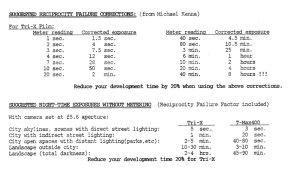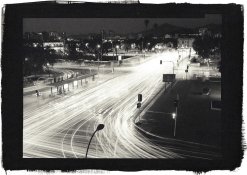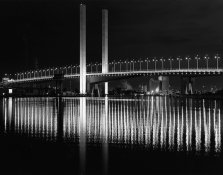I'm very rusty when it comes to night photography. Many years ago I had a book that had a great Kodak table for starting suggestions for night photos, alas, google cannot seem to find it. Anyway, I was out tonight and came across this view (captured with an iphone) I want to return to soon with my 67, it will be loaded with ACROS 100. Can someone give me a starting exposure from which to bracket from? The vertical pylons are very bright as they are floodlit. I was thinking 5 seconds at f5.6 and bracket in one stop increments up to 40 seconds, although I wouldn't mind the water to stay quite sharp and not go milky with movement. I'l probably be doing this well after sunset.

You are using an out of date browser. It may not display this or other websites correctly.
You should upgrade or use an alternative browser.
You should upgrade or use an alternative browser.
Night exposure advice needed
-
A
- Thread starter markbau
- Start date
Recent Classifieds
-
For Sale 8x10 film developing hanger - 4-up 4x5
- Started by mfohl
-
For Sale 8x10 film developing hanger - 2-up 5x7
- Started by mfohl
-
For Sale Rollei SL66 E 220 back
- Started by campy51
-
For Sale Schneider Kreuznach Centerfilter III
- Started by Guivd
-
For Sale Expired film
- Started by Richelle4c
Forum statistics
Vaughn
Subscriber
Here is something Micheal Kenna shared at a workshope a few decades ago. The TMax times might be of some help, but going out and doing it will be the best!
The photo was taken with FP4+ film (ASA100), F32 at 10 minutes.
The photo was taken with FP4+ film (ASA100), F32 at 10 minutes.
Attachments
DWThomas
Subscriber
There's a .PDF file that surfaces occasionally on the web that can be printed and cut to make a sort of slide rule. It lists a whole range of scenes which are numbered and used to set the slide. I've attached a copy for what it might be worth.
Unless the phone can display EXIF data on its images (perhaps a separate app), it won't be too helpful, but in theory a digital camera could be used to determine a setting. The good part is a scene like you show will almost always produce at least something, as the individual dots of light are quite intense. Acros is a good choice as it has low reciprocity failure for long exposures. (We can hope Acros II will maintain that tradition!)
Unless the phone can display EXIF data on its images (perhaps a separate app), it won't be too helpful, but in theory a digital camera could be used to determine a setting. The good part is a scene like you show will almost always produce at least something, as the individual dots of light are quite intense. Acros is a good choice as it has low reciprocity failure for long exposures. (We can hope Acros II will maintain that tradition!)
Attachments
Thanks for the replies and the jiffy calculator! It never occurred to me to look at the exif data. Here's what it said. ISO 1000, f2.2, 1/17th sec. I did some rounding (ISO 800, 15th sec, f2) At ISO 100 this would equate to: 4 sec at f5.6. So maybe the bracket should be 2 sec, 4 sec, 8 sec, 16 sec, 32 sec. Does that sound about right?
DWThomas
Subscriber
I think so -- I might even start at 1 second. The great unknown is what mysteries go on inside those phones as far as relating the indicated exposure parameters to anything external to the phone. I currently have an iPhone 6S which sometimes does a remarkable job, especially in low light, but other times -- backlighting as an example -- can be a frustration.So maybe the bracket should be 2 sec, 4 sec, 8 sec, 16 sec, 32 sec. Does that sound about right?
Sirius Glass
Subscriber
Usually I say "it's really hard to overexpose film at night", especially when you factor in reciprocity failure, but those pillars might be tough to hold detail. Your bracketing is probably fine, maybe even go to a minute. I would decrease development time by about 30% to try and tame the hilights.
etn
Subscriber
I would be interested to know what kind of meter can measure such low light levels:

Doc W
Member
I made printout of the "Jiffy Calculator" and tried to get it to work but it seems a little odd. I must be doing something wrong. Here is what I did.
I printed the whole pdf and then trimmed it into two pieces: the one on the left with the film speed and time columns; and the other with the slot for film speed and shutter speed.
On the main piece, I cut out the space for the Film Speed column and for the Shutter Speed. I folded it over as indicated and then put the smaller piece inside the larger.
I lined up the film speed (100, or a modestly rated FP4) with scene #6 (brightly lit gas station). The calculator gave me an expore time of 3 seconds @ f/32. The photo that Vaughn posted was also ASA 100 and f/32, but was exposed for 10 minutes!
Where did I go wrong (other than deciding to get into photography many years ago)?
I printed the whole pdf and then trimmed it into two pieces: the one on the left with the film speed and time columns; and the other with the slot for film speed and shutter speed.
On the main piece, I cut out the space for the Film Speed column and for the Shutter Speed. I folded it over as indicated and then put the smaller piece inside the larger.
I lined up the film speed (100, or a modestly rated FP4) with scene #6 (brightly lit gas station). The calculator gave me an expore time of 3 seconds @ f/32. The photo that Vaughn posted was also ASA 100 and f/32, but was exposed for 10 minutes!
Where did I go wrong (other than deciding to get into photography many years ago)?
Doc W
Member
Oops, I see why the photo posted by Vaughn was so much longer (light trails). But in the one I looked up in the table (brightly lit gas station), the exposure just doesn't seem right (ASA 100, f/f32 for three seconds)
pentaxuser
Member
I wonder if the answer is that a brightly lit gas station is in fact many times brighter than the Vaughn shot in terms of instant intensity. His only looks bright because it took many minutes for enough traffic to build up that accumulation of light. So both times, yours and his may in fact be correctI made printout of the "Jiffy Calculator" and tried to get it to work but it seems a little odd. I must be doing something wrong. Here is what I did.
I printed the whole pdf and then trimmed it into two pieces: the one on the left with the film speed and time columns; and the other with the slot for film speed and shutter speed.
On the main piece, I cut out the space for the Film Speed column and for the Shutter Speed. I folded it over as indicated and then put the smaller piece inside the larger.
I lined up the film speed (100, or a modestly rated FP4) with scene #6 (brightly lit gas station). The calculator gave me an expore time of 3 seconds @ f/32. The photo that Vaughn posted was also ASA 100 and f/32, but was exposed for 10 minutes!
Where did I go wrong (other than deciding to get into photography many years ago)?
Just a thought
pentaxuser
f/32 @ 3 seconds is approximately the same as f/10 at 1/8 of a second.Oops, I see why the photo posted by Vaughn was so much longer (light trails). But in the one I looked up in the table (brightly lit gas station), the exposure just doesn't seem right (ASA 100, f/f32 for three seconds)
Sounds about right for gas station lighting
 .
.Doc W
Member
Thanks guys. This weekend, I hope to enter .. The Dark (mysterious music follows).

Vaughn
Subscriber
First, one meters 'wide open' with in-camera meters. If one meters with a f2.8 lens and gets a reading, then one increases the time if one is closing the lens down to f16. That time can be quite long even before adding time for resiprocity failure.I would be interested to know what kind of meter can measure such low light levels:
Second, there are very sensitive light meters out there (LunaPros, for example).
Third, read off a white card instead of a grey card and adjust your readings accordingly -- you can read several stops less light with your meter that way.
Vaughn
Subscriber
I took a meter reading (Pentax Digital Spot) of the pavement w/o headlights and based my exposure on that. I shut down to f32 because I wanted a very long exposure, not for DoF. I like what closing down did to the street lights, too -- almost like a star filter, but much more mellow.Oops, I see why the photo posted by Vaughn was so much longer (light trails). But in the one I looked up in the table (brightly lit gas station), the exposure just doesn't seem right (ASA 100, f/f32 for three seconds)
I took two images. The first one was f32 at 2 minutes. The light dropped another three stops before I took the next one at 10 minutes (the pavement went from 3 down to 0.5 on my meter...based on all that and the desire to hold the detail on the pavement (Zone 3), the uncorrected exposure should have been 4 minutes. I gave the sheet of film heavy development for future platinum and/or carbon printing.
I wanted to keep that twilight glow in the sky's horizon...and I wanted more lights to be on in the various apt. buildings. The photo was taken at around 10pm (not long after summer solstice). Note that I able to keep the trunk of the palm tree on the horizon separated from the mountain behind it -- print exposure had to be right on, too.
Last edited:
Doc W
Member
Vaughn, thanks for that detailed description of the exposure. That was very helpful. And it's a terrific photo.
| Photrio.com contains affiliate links to products. We may receive a commission for purchases made through these links. To read our full affiliate disclosure statement please click Here. |
PHOTRIO PARTNERS EQUALLY FUNDING OUR COMMUNITY:  |







